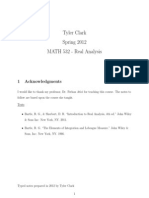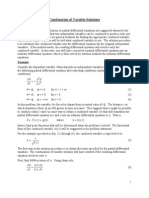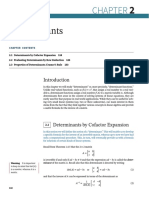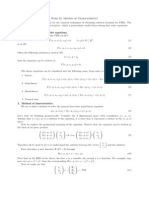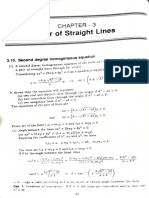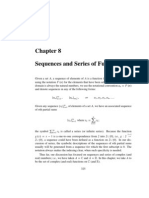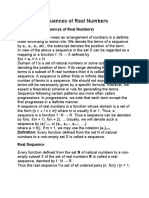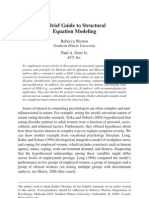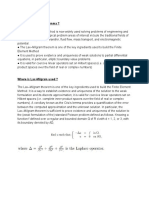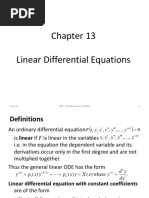1analytic and Harmonic Functions
Uploaded by
Nelvin Rivera Nool1analytic and Harmonic Functions
Uploaded by
Nelvin Rivera Nool2.
4 Analytic and Harmonic Functions
We begin our discussion with famous equations called the Cauchy-Riemann
equations.
A necessary but not sufficient condition for a function ( ) ( ) ( ) f z u x, y iv x, y = + to be
differentiable at a complex number
0
z is for f to satisfy the CRE at ( )
0 0 0
z x , y =
Example 2.22: Use the Cauchy Riemann Equations to prove that ( ) f z z = is not
differentiable anywhere in .
Solution:
( ) f z z x iy = =
( ) ( ) u x, y x v x, y y = =
1 1
x y
u v = =
0 ,
y
u = 0
x
v =
Note that
x y
u v x, y = for all , f z x yi = + therefore is not differentiable for all
Theorem 2.4.1 Cauchy Riemann Equations
Suppose that
f(z) = u(x, y) + iv(x, y)
and that f(z) exists at a point z
0
= x
0
+ iy
0
. Then the first order partial derivatives of
u and v must exist at (x
0
, y
0
) and they must satisfy the Cauchy-Riemann Equations
u
x
= v
y
and u
y
= -v
x
at [x
0
,y
0
]. Also, f(z
0
) can be written as
f(z
0
) = u
x
+ iv
x
Example 2.23: Determine the largest possible subset of where f is differentiable,
given
( ) ( )
( ) ( )
a
b
f z xy iy
f z sin xcosh y i cos x sinh y
= +
= +
Solution:
( ) ( ) f z xy iy = + a
u xy v y = =
1
x y
u y v = =
0
y x
u x v = =
are all continuous for all
x y, x y
u , u v , v z
1
0
imples that
Thus CRE is satisfied only at
imples that
,
x y
y x
u v y
z i
u v x
= =
=
`
= =
)
( ) Therefore exists only at f z z i ' = and ( ) 1. f i ' =
Theorem 2.4.2 Let ( ) ( ) ( ) f z u x, y iv x, y = + be defined on a ball containing
0 0 0
z x iy = + . If u and v satisfy the Cauchy-Riemann Equations
at ( )
0 0
x , y and both u and v have continuous first partial
derivatives at ( )
0 0
x , y , then ( )
0
f z ' exists, and we have
( ) ( ) ( )
0 0 0 0 0 x x
f z u x , y iv x , y ' = +
( ) ( )
0 0 0 0 y y
v x , y iu x , y =
( ) ( ) f z sin xcosh y i cos x sinh y = + b
( ) u x, y sinxcosh y =
( ) v x, y cos x sinh y =
and
CRE is satisfied for all
and
x y
y x
u cos xcosh y v cos xcosh y
x, y
u sin x sinh y v sin x sinh y
= =
`
= =
)
are all continuous for all
x y x y
u , u , v , v x, y.
( ) Therefore exists for all z f z e ' and ( ) . f z cos xcosh y i sin x sinh y ' =
We now derive the Cauchy-Riemann Equations in polar coordinates.
We note that
( ) ( ) But .
x x
f z u iv x r cos , y r sin , z r cis ' = + = = =
Now, ( ) ( ) ( ) let f z u r, iv r, = + . We then have the following
( )
x r x x
u u r u
= + a
( )
y r y y
u u r u
= + b
( )
x r x x
v v r v
= + c
( )
y r y y
v v r v
= + d
We need to determine
x y x y
r r , , ,
x r cos =
( ) 1 Differentiating with respect to :
x x
x r sin r cos = + (e)
( )
0 Differentiating with respect to :
y y
y r sin r cos = + (f)
y r sin =
( ) 0 Differentiating with respect to :
x x
x r cos r sin = + (g)
( )
1 Differentiating with respect to :
y y
y r cos r sin = + (h)
( ) ( ) Using e and g , we have
( ) 1
x x
cos r sin r cos = +
( ) 0
x x
sin r cos r sin = +
2
2
0
x x
x x
x
cos r sin cos r cos
r sin cos r sin
cos r
= +
= +
=
By substitution in eq (g), we have
0
x
x
r cos cos sin
sin
r
= +
=
( ) ( ) Using f and h
( )
( )
0
1
y y
y y
y
cos r sin r cos
sin r cos r sin
r sin
= +
= +
=
By substitution in eq (f), we have
0
y
y
r sin sin cos
cos
r
= +
=
Thus, from eq( )
x r x x
u u r u
= + a :
x r
u sin
u u cos
r
=
from eq (b):
y r
u cos
u u sin
r
= +
from eq (c):
x r
v sin
v v cos
r
=
from eq (d):
y r
v cos
v v sin
r
= +
By CRE:
x y
u v = and
Y x
u v = :
r r
u sin v cos
u cos v sin
r r
= +
and
Y x
u v = :
r r
u cos v sin
u sin v cos
r r
+ = +
Finally, we have the CRE in polar coordinates:
v
u
r
r
= and
r
u
v
r
=
Now, since ( )
x x
f z u iv ' = + , then we have
( ) ( )( )
r r
f z u iv cos i sin ' = +
Thus, if ( ) ( ) ( ) f z u r, iv r, = + , then f is differentiable at
i
z r cis re
= = if
u, v satisfy the CRE in polar coordinates and
r
u , u , v
and
r
v are continuous at
.
i
z re
=
Example 2.24: Determine where ( ) f z ' exists given
( )
2
i
f z re ,
= < <
Solution:
( ) ( )
2 2
; u r, r cos v r, r sin
= =
1 1
2 2 2 2
r
u cos v r cos
r
= =
1 1
2 2 2 2
r
u r sin v sin
r
= =
0 Note that all are continuous for all , r >
By CRE , we have
1
2 2
r
v
cos u
r r
= = and
1
2 2
r
u
sin v
r r
= =
Theorem 2.4.3 Let the function
f(z) = u(r, ) + iv(r, )
be defined throughout some neighborhood of a non-zero point
z
0
= r
o
i
e
and suppose that the first-order partial derivatives of the
functions u and v with respect to r and exist everywhere in that
neighborhood. If those partial derivatives are continuous at (r
0
,
0
) and satisfy the polar form
ru
r
=
v and
u = -rv
r
of the Cauchy-Riemann equations at (r
0
,
0
), then f (
0
) exists.
The derivative f (
0
) is given by
f (z
0
) =
i
e
(u
r
+ iv
r
)
where the right hand side is to be evaluated at (r
0
,
0
).
( )
2
Thus, is differentiable everywhere except at the origin.
i
f z re , ,
= < <
Example 2.25: Let
( ) ( )
2 2 2
2 f z z x y xyi = = +
Therefore, is entire. f
Example 2.26: Suppose ( )
2 2
1
x yi
f z
z x y
= =
+
Then,
( )
2 2 2 2
;
x y
u x, y v
x y x y
= =
+ +
( )( ) ( )
( )
( )( ) ( )
( )
2 2 2 2
2 2
2 2 2 2
1 2 0 2
x y
x y x x x y x y
u u
x y x y
+ +
= =
+ +
( ) ( )
2 2
2 2
2 2 2 2
2
x y
y x xy
u u
x y x y
= =
+ +
0 is analytic everywhere except at f z = and 0 thus, is a singular point. z =
Definition 2.4.3:
5. A function f is analytic at a point
0
z if there exists an open ball ( )
0
B z ,
such that ( ) f z ' exists for all ( )
0
z B z , e .
0
z
( )
( )
0
z B z , z
f z
e
' exists
6. f is analytic at a region R _ if f is analytic at every z R e .
7. If f is analytic at every complex number z then f is an entire function.
8. If f is analytic at every point in a ball ( )
0
B z , except at
0
z , then
0
z is
called a singular point of f .
( ) 2 for all f z z z ' = e
Definition 2.4.3:
1. A function f is analytic at a point
0
z if there exists an open ball ( )
0
B z ,
such that ( ) f z ' exists for all ( )
0
z B z , e .
0
z
( )
( )
0
z B z , z
f z
e
' exists
2. f is analytic at a region R _ if f is analytic at every z R e .
3. If f is analytic at every complex number z then f is an entire function.
4. If f is analytic at every point in a ball ( )
0
B z , except at
0
z , then
0
z is
called a singular point of f .
Example 2.27: Consider ( ) f z z x yi = =
1 1
0 0
x y
y x
u x v y
u v
u v
= =
= =
= =
We note that CRE are not satisfied. Hence f (z) does not exist everywhere and f
is not analytic everywhere.
Example 2.28: ( ) ( )
3
3
1 f z x i y = +
( )
3
3
1 , u x v y = =
( )
2
2
3 3 1 ,
x y
u x v y = =
0 0
y x
u v = =
Thus, ( )
2
2
1 x y =
2
0 1 0 and x y = =
0 1 x y = =
This means that CRE satisfied only at z i = , and so ( ) exists only at f z z i ' =
Consequently, is not analytic anywhere. f
Example 2.29 The quotient f(z) =
) 1 )( 3 (
4
2 2
3
+
+
z z
z
is analytic throughout the z-plane except for
the singular points z = 3 and z = i .
EXERCISES 2.4
1. Show that f(z) and its derivative f(z) exist everywhere and find f(z) when
a. f(z) = iz + 2
b. f(z) = z
3
c. f(z) = sin(x) cosh(y) + i cos(x) sinh(y)
2. Determine where f(z) exists and find its value when
a.
2 2
( ) f z x iy = + b.
3 3
( ) (1 ) f z x i y = + c. f(z) = z Imz
3. Use the polar coordinates to find f(z) if
4
1
( ) f z
z
=
4. Find the singular points:
4.1
3
2 1
( )
z
f z
z z
+
=
+
4.2
3
2
( )
3 2
z i
f z
z z
+
=
+
4.3
( ) ( )
2
2
1
( )
2 2 2
z
f z
z z z
+
=
+ +
You might also like
- Complete Answer Guide for Linear Algebra with Applications 5th Edition Bretscher Solutions Manual100% (3)Complete Answer Guide for Linear Algebra with Applications 5th Edition Bretscher Solutions Manual60 pages
- Instant Download Finite Dimensional Linear Algebra 1st Gockenbach Solution Manual PDF All Chapter100% (3)Instant Download Finite Dimensional Linear Algebra 1st Gockenbach Solution Manual PDF All Chapter69 pages
- Teorema Limit, Satu Sisi, Apit, Trigonometri&Tak HinggaNo ratings yetTeorema Limit, Satu Sisi, Apit, Trigonometri&Tak Hingga117 pages
- Mood - Introduction To The Theory of Statistics81% (21)Mood - Introduction To The Theory of Statistics577 pages
- A Brief Course in Mathematical Statistics 1st Edition Tanis Hogg Solution Manual0% (1)A Brief Course in Mathematical Statistics 1st Edition Tanis Hogg Solution Manual8 pages
- Kooistra - Trigonometric Inequalities in A TriangleNo ratings yetKooistra - Trigonometric Inequalities in A Triangle11 pages
- MATH 223: Calculus II: Dr. Joseph K. AnsongNo ratings yetMATH 223: Calculus II: Dr. Joseph K. Ansong28 pages
- Solved Chapter 11.1 Problem 17P Solution Advanced Engineering Mathematics 10th EditionNo ratings yetSolved Chapter 11.1 Problem 17P Solution Advanced Engineering Mathematics 10th Edition3 pages
- 2.5: Numerical Integration - Midpoint, Trapezoid, Simpson's RuleNo ratings yet2.5: Numerical Integration - Midpoint, Trapezoid, Simpson's Rule8 pages
- WINSEM2021-22 ECE2006 ETH VL2021220501673 Reference Material I 03-03-2022 Bilinear TransNo ratings yetWINSEM2021-22 ECE2006 ETH VL2021220501673 Reference Material I 03-03-2022 Bilinear Trans46 pages
- Solved A Track Star Runs Two Races On A Certain Day PDFNo ratings yetSolved A Track Star Runs Two Races On A Certain Day PDF1 page
- Bartle R.G.-the Elements of Real Analysis (1967)No ratings yetBartle R.G.-the Elements of Real Analysis (1967)462 pages
- 4.4 Monotone Sequences and Cauchy SequencesNo ratings yet4.4 Monotone Sequences and Cauchy Sequences8 pages
- Applied Mathematics and Sciences: An International Journal (MathSJ)No ratings yetApplied Mathematics and Sciences: An International Journal (MathSJ)2 pages
- Charalambos D. Aliprantis, Owen Burkinshaw-Problems in Real Analysis, Second Edition-Academic Press (1998)No ratings yetCharalambos D. Aliprantis, Owen Burkinshaw-Problems in Real Analysis, Second Edition-Academic Press (1998)410 pages
- MAT389 Fall 2016, Problem Set 3: FunctionsNo ratings yetMAT389 Fall 2016, Problem Set 3: Functions9 pages
- Unit - III Complex Numbers:: Re Z 2 2 X R +No ratings yetUnit - III Complex Numbers:: Re Z 2 2 X R +20 pages
- Ae2 Mathematics: Complex Variables: J. D. GibbonNo ratings yetAe2 Mathematics: Complex Variables: J. D. Gibbon12 pages
- Mathematical Investigation and Its Assessment100% (2)Mathematical Investigation and Its Assessment19 pages
- Country Report: Condition and Practices On E-LearningNo ratings yetCountry Report: Condition and Practices On E-Learning10 pages
- A Guide To Structural Equation Modeling PDFNo ratings yetA Guide To Structural Equation Modeling PDF33 pages
- Edukasyong An at Pangkabuhayan (Epp) - K To 12 Curriculum92% (53)Edukasyong An at Pangkabuhayan (Epp) - K To 12 Curriculum46 pages
- Day 2 Presentation 2. CCE Guidelines by Engr. GrazaNo ratings yetDay 2 Presentation 2. CCE Guidelines by Engr. Graza47 pages
- Practical Finite Element Analysis For Mechanical Engineers - Dominique Madier - Ch1No ratings yetPractical Finite Element Analysis For Mechanical Engineers - Dominique Madier - Ch115 pages
- MTH101: Calculus I Lecture 6: Differentiation Formulas: International Burch UniversityNo ratings yetMTH101: Calculus I Lecture 6: Differentiation Formulas: International Burch University17 pages
- Implicit Differentiation and Higher-Order Derivative: Tony UNo ratings yetImplicit Differentiation and Higher-Order Derivative: Tony U26 pages
- AM/ECON 11B, Fall 2019. MWF 2:40 - 3:45 PM, Earth&Marine B206 CanvasNo ratings yetAM/ECON 11B, Fall 2019. MWF 2:40 - 3:45 PM, Earth&Marine B206 Canvas6 pages
- Differential Equation - Examples of Integrating FactorsNo ratings yetDifferential Equation - Examples of Integrating Factors4 pages
- Practical-8 Plot The Integral Surfaces of A Given First Order PDE With Initial DataNo ratings yetPractical-8 Plot The Integral Surfaces of A Given First Order PDE With Initial Data9 pages
- DP - 11 - FA - 1 - T4 - P1 Differential Calculus MSNo ratings yetDP - 11 - FA - 1 - T4 - P1 Differential Calculus MS6 pages
- Instant download Mathematics for Economics third edition The MIT Press Michael Hoy pdf all chapter100% (2)Instant download Mathematics for Economics third edition The MIT Press Michael Hoy pdf all chapter67 pages
- Aksum University College of Natural & Computational Sciences Department of Mathematics Assignment-1 of Partial Differential EquationsNo ratings yetAksum University College of Natural & Computational Sciences Department of Mathematics Assignment-1 of Partial Differential Equations11 pages
- Calculus-Formulae (© MD Hafiz Uddin) PDFNo ratings yetCalculus-Formulae (© MD Hafiz Uddin) PDF3 pages
- Chapter 1 Advanced Differentiation: Example 1 SolutionNo ratings yetChapter 1 Advanced Differentiation: Example 1 Solution16 pages
- Summation by Parts Operators For Finite Difference Approximations of Second-Derivatives With Variable CoefficientsNo ratings yetSummation by Parts Operators For Finite Difference Approximations of Second-Derivatives With Variable Coefficients33 pages
- 07-MATH 102 Calculus II (N. Gjini) Eng SignedNo ratings yet07-MATH 102 Calculus II (N. Gjini) Eng Signed6 pages
- Complete Answer Guide for Linear Algebra with Applications 5th Edition Bretscher Solutions ManualComplete Answer Guide for Linear Algebra with Applications 5th Edition Bretscher Solutions Manual
- Instant Download Finite Dimensional Linear Algebra 1st Gockenbach Solution Manual PDF All ChapterInstant Download Finite Dimensional Linear Algebra 1st Gockenbach Solution Manual PDF All Chapter
- Teorema Limit, Satu Sisi, Apit, Trigonometri&Tak HinggaTeorema Limit, Satu Sisi, Apit, Trigonometri&Tak Hingga
- A Brief Course in Mathematical Statistics 1st Edition Tanis Hogg Solution ManualA Brief Course in Mathematical Statistics 1st Edition Tanis Hogg Solution Manual
- Kooistra - Trigonometric Inequalities in A TriangleKooistra - Trigonometric Inequalities in A Triangle
- Solved Chapter 11.1 Problem 17P Solution Advanced Engineering Mathematics 10th EditionSolved Chapter 11.1 Problem 17P Solution Advanced Engineering Mathematics 10th Edition
- 2.5: Numerical Integration - Midpoint, Trapezoid, Simpson's Rule2.5: Numerical Integration - Midpoint, Trapezoid, Simpson's Rule
- WINSEM2021-22 ECE2006 ETH VL2021220501673 Reference Material I 03-03-2022 Bilinear TransWINSEM2021-22 ECE2006 ETH VL2021220501673 Reference Material I 03-03-2022 Bilinear Trans
- Solved A Track Star Runs Two Races On A Certain Day PDFSolved A Track Star Runs Two Races On A Certain Day PDF
- Applied Mathematics and Sciences: An International Journal (MathSJ)Applied Mathematics and Sciences: An International Journal (MathSJ)
- Charalambos D. Aliprantis, Owen Burkinshaw-Problems in Real Analysis, Second Edition-Academic Press (1998)Charalambos D. Aliprantis, Owen Burkinshaw-Problems in Real Analysis, Second Edition-Academic Press (1998)
- Country Report: Condition and Practices On E-LearningCountry Report: Condition and Practices On E-Learning
- Edukasyong An at Pangkabuhayan (Epp) - K To 12 CurriculumEdukasyong An at Pangkabuhayan (Epp) - K To 12 Curriculum
- Day 2 Presentation 2. CCE Guidelines by Engr. GrazaDay 2 Presentation 2. CCE Guidelines by Engr. Graza
- Practical Finite Element Analysis For Mechanical Engineers - Dominique Madier - Ch1Practical Finite Element Analysis For Mechanical Engineers - Dominique Madier - Ch1
- MTH101: Calculus I Lecture 6: Differentiation Formulas: International Burch UniversityMTH101: Calculus I Lecture 6: Differentiation Formulas: International Burch University
- Implicit Differentiation and Higher-Order Derivative: Tony UImplicit Differentiation and Higher-Order Derivative: Tony U
- AM/ECON 11B, Fall 2019. MWF 2:40 - 3:45 PM, Earth&Marine B206 CanvasAM/ECON 11B, Fall 2019. MWF 2:40 - 3:45 PM, Earth&Marine B206 Canvas
- Differential Equation - Examples of Integrating FactorsDifferential Equation - Examples of Integrating Factors
- Practical-8 Plot The Integral Surfaces of A Given First Order PDE With Initial DataPractical-8 Plot The Integral Surfaces of A Given First Order PDE With Initial Data
- DP - 11 - FA - 1 - T4 - P1 Differential Calculus MSDP - 11 - FA - 1 - T4 - P1 Differential Calculus MS
- Instant download Mathematics for Economics third edition The MIT Press Michael Hoy pdf all chapterInstant download Mathematics for Economics third edition The MIT Press Michael Hoy pdf all chapter
- Aksum University College of Natural & Computational Sciences Department of Mathematics Assignment-1 of Partial Differential EquationsAksum University College of Natural & Computational Sciences Department of Mathematics Assignment-1 of Partial Differential Equations
- Chapter 1 Advanced Differentiation: Example 1 SolutionChapter 1 Advanced Differentiation: Example 1 Solution
- Summation by Parts Operators For Finite Difference Approximations of Second-Derivatives With Variable CoefficientsSummation by Parts Operators For Finite Difference Approximations of Second-Derivatives With Variable Coefficients
















